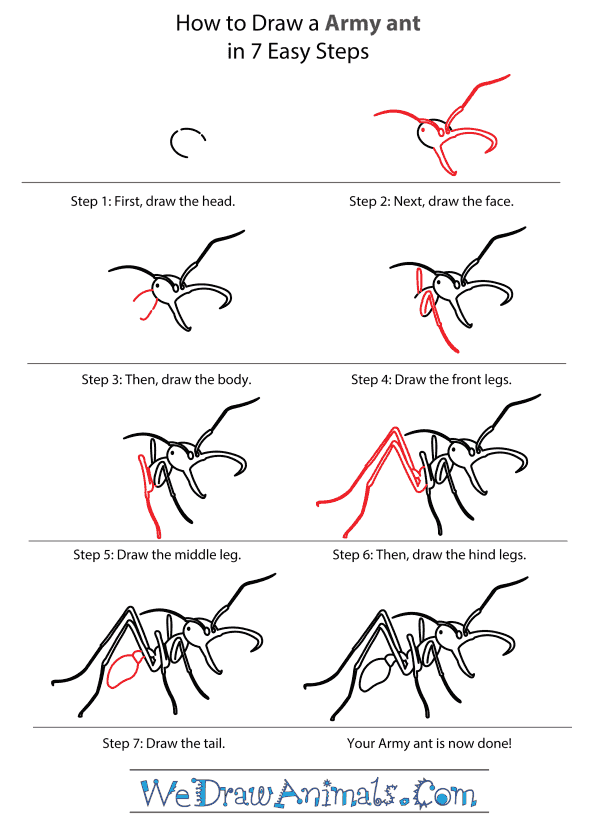In this quick tutorial you'll learn how to draw an Army Ant in 7 easy steps - great for kids and novice artists.
The images above represent how your finished drawing is going to look and the steps involved.
Below are the individual steps - you can click on each one for a High Resolution printable PDF version.
At the bottom you can read some interesting facts about the Army Ant.
Make sure you also check out any of the hundreds of drawing tutorials grouped by category.
How to Draw an Army Ant - Step-by-Step Tutorial
Step 1: Let's start drawing our army ant with the head. Draw a circle - leave two small gaps for the antenae and a large gap for the mandibles.
Step 2: Let's draw the face - draw a small dot on the left side and two long antanae at the front of the head with circles at the base of each. Draw two more large pointy shape, this time curving them inwards.
Step 3: Now we can draw the first part of the body. Simply draw two small lines. Leave a small and big gap.
Step 4: Draw the front legs - draw a thin oval on the left side and a thin bent oval into a point on the right side.
Step 5: Draw the middle leg on the right side of the front right leg.
Step 6: Alright, now we can draw the ant's back legs. Make them longer than the front legs in a triangular shape.
Step 7: Lastly, draw the tail by making a large round shape at the back, attached to a smaller round shape.
Interesting Facts about the Army Ant
The Army ant (Eciton burchellii) is the most popular ant species to study. The species is found in the Amazon jungle and Central America. They stay in damp and shaded areas, avoiding direct sunlight.
Did you know?
- Army ants have a specific social structure, known as castes. Each caste has a specific job that they do for the colony.
- Their highest caste are soldiers, who are larger than the other army ants.
- Unlike some ants, army ants cannot regulate their own internal temperature. This means they must rely on the location and build of their nests to keep them from overheating or freezing.
- Army ants go on “raids” every day to every other day depending on their breeding cycle. These raids never cover the same area twice, and they avoid areas where other colonies are raiding.
- They feed on other insects, but due to the way they raid, some small insects can hide from them. This means they do not completely strip their hunting grounds.
Lesson plan note: Discuss the how army ants hunt and where they choose to hunt, and how that will help them find more food and avoid fights with other colonies.








